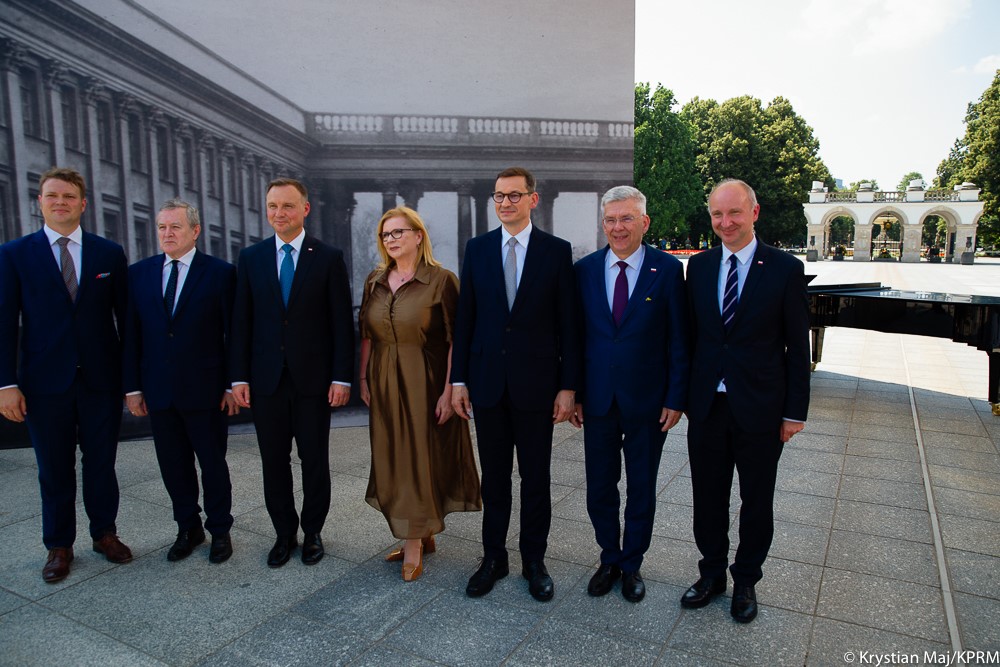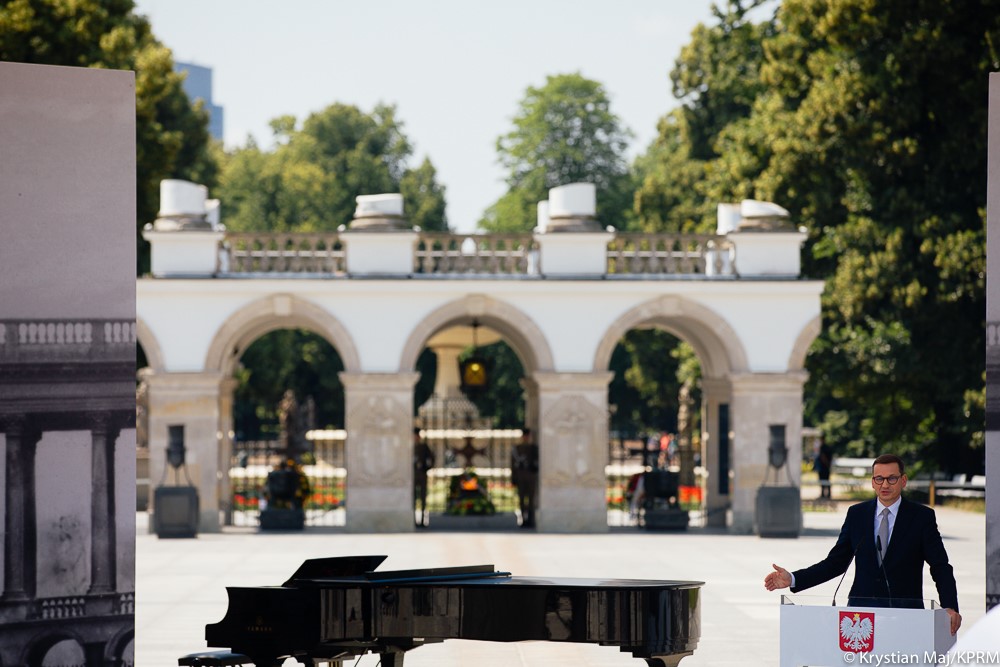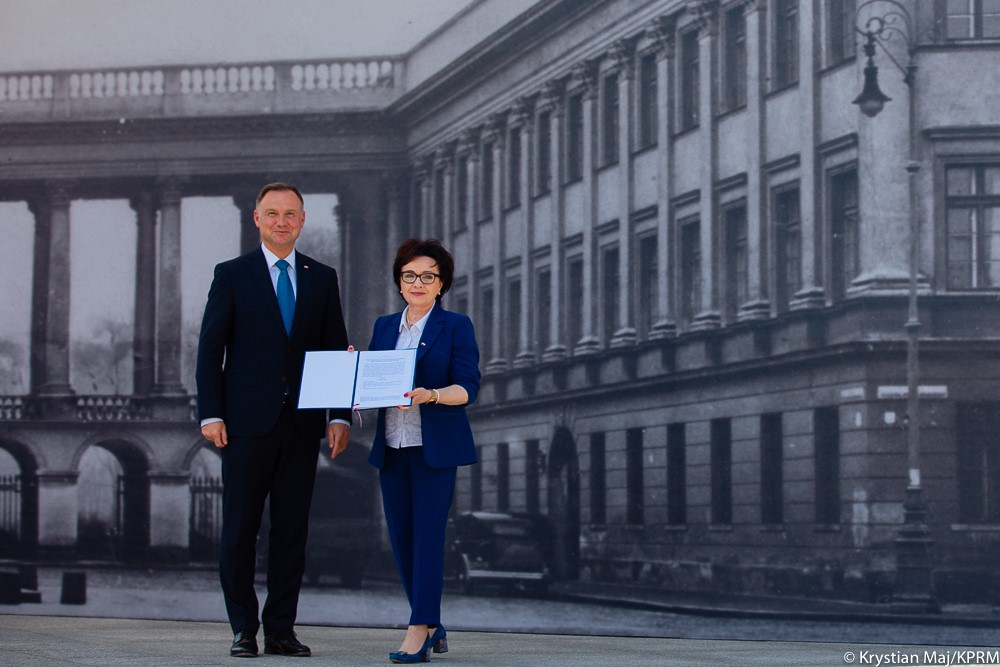Prime Minister Mateusz Morawiecki: Let this be a cross-party and national object that will unite us. The Saxon Palace can become the beating heart of the reborn Third Polish Republic
07.07.2021
The idea of rebuilding the Saxon Palace is part of the Polish Deal programme. As a result, the most important palace in Warsaw will regain its former glory, while Warsaw will regain prestigious and attractive space for cultural and educational purposes. The draft act provides for the reconstruction to begin in 2023. The draft act also provides for the reconstruction of the remaining buildings, which used to constitute the frontage of the Piłsudski Square before World War II, namely the Brühl Palace building and three tenement houses at ul. Królewska. Mateusz Morawiecki, the President of the Council of Ministers, participated in a ceremony, in which President of Poland Andrzej Duda presented the Marshal of the Sejm with the draft Act on the preparation and implementation of the investment concerning the reconstruction of the Saxon Palace, Brühl Palace, and tenement houses at ul. Królewska in Warsaw.

“The German plans for the destruction of Warsaw included blowing up those magnificent buildings. They served as a reflection of Poland’s power and meant that Poland is to last,”
said the Prime Minister while recalling the history of the Saxon Palace, Brühl Palace, and the tenement houses at ul. Królewska in Warsaw, adding that:
”The German plan to destroy Poland also covered the destruction of Polish culture, because the strength of Polish identity lies in it. It is the strength that can lead to the rebirth of the Polish state.”
He stressed that we had had to wait long for such initiative. He also recalled that President Lech Kaczyński was the one who deserved the credit.
”The first reconstruction phase was something that President Lech Kaczyński started – he managed to include the Saxon Palace in our plans 60 years after its destruction,” continued the Prime Minister.
During his speech, the President thanked Prime Minister Mateusz Morawiecki for including the reconstruction of the Saxon Palace, Brühl Palace, and the tenement houses at ul. Królewska in the grand Polish Deal programme.
Declaration of reconstruction of the Saxon Palace
In 2018 – the year involving ceremonies commemorating the 100th anniversary of Poland regaining independence – President of Poland Andrzej Duda stated that he was in favour of rebuilding the Saxon Palace as a permanent symbol of the 100th anniversary of Poland regaining independence.
On 11 November 2018, he issued the Declaration of Restoration of the Saxon Palace. On 12 December 2018, the Committee for National Celebrations of the 100th Anniversary of Regaining Independence summed up previous works on the reconstruction of the Saxon Palace. On that day, it was decided that a draft act on special rules for the implementation of the investment concerning the reconstruction of the Saxon Palace would be prepared.
Assumptions of the draft act
The draft act sets out that the reconstruction of the Saxon Palace is to begin in 2023. The undertaking was the idea of Lech Kaczyński, the President of the Capital City of Warsaw. New facades will restore the appearance of the Palace as it was in August 1939, with the interior being functional and modern.
Apart from the Saxon Palace, the draft act also provides for the reconstruction of the remaining buildings, which used to constitute the western frontage of the Piłsudski Square before World War II, namely the Brühl Palace building, and three tenement houses at ul. Królewska, i.e. Ludwik Malhome tenement house and Lessel / Strasburger tenement house. In addition, the draft act covers the reconstruction of buildings at ul. Królewska in Warsaw, which were destroyed during World War II and would complete the western frontage of the Piłsudski Square.
The planned Saxon Palace reconstruction also aims to restore the original full form of the Tomb of the Unknown Soldier, which was unveiled in 1925 in the arcades of the Saxon Palace colonnade, and to integrate the current form of the tomb with the rebuilt colonnade.
The draft act also covers the establishment of the Reconstruction Council to serve as an advisory body to the Minister of Culture and National Heritage. It will be composed of 5 persons and the General Conservator of Historical Monuments will be the ex officio chairman of the Council.
History of the Palace
The history of the Piłsudski Square and buildings having formed its western part until December 1944 dates back to the 17th century and the szlachta and aristocratic times of the Morsztyn and Ossoliński families. Destroyed during World War II, the buildings served various functions in the past and had been converted many times.
Together with the Saxon Palace and the Brühl Palace, the Piłsudski Square became the heart of the reborn Polish state, where various types of parades, including military ones, demonstrations, and the most important national and church ceremonies were held. After Poland regained independence, the buildings at the Saxon Palace of the time became the seats of the most important institutions from the point of view of the country that had just only become independent.




